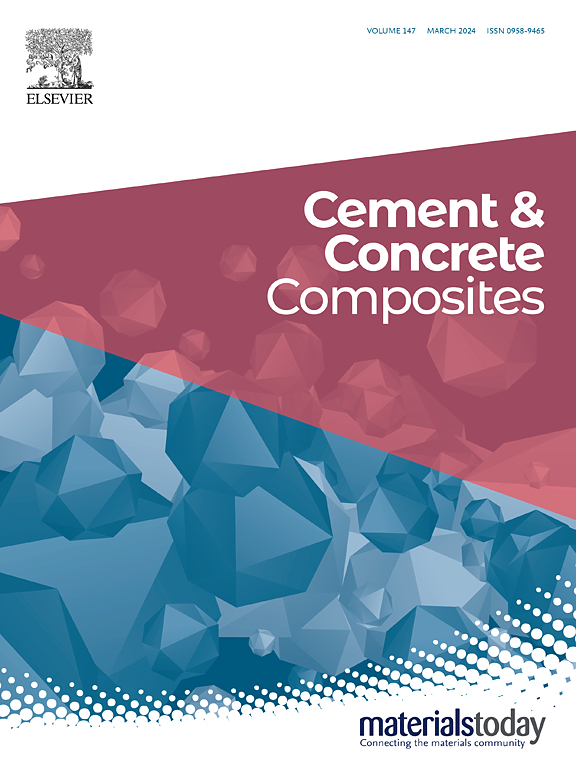Development of high-performance phosphogypsum-based cementitious materials through CO2-assisted alkali activation
IF 13.1
1区 工程技术
Q1 CONSTRUCTION & BUILDING TECHNOLOGY
引用次数: 0
Abstract
Phosphogypsum (PG)-based cementitious materials often suffer from low strength and poor water resistance, especially when incorporating a high volume of PG. This issue arises mainly from the high solubility of CaSO4·2H2O. This study develops a novel CO2-assisted alkali activation method for phosphogypsum-based cementitious materials (HPCM), improving compressive strength to 49.3 MPa (+50.83 %) and enhancing water resistance (softening coefficient: 0.97). The presence of alkali created a favorable environment for the carbonation of PG, forming a core-shell structure with PG as the core and calcite and C-S-H forming the inner layer and outer shell, respectively. This core-shell structure effectively mitigated sulfate leaching during alkali activation while enhancing the chemical bonding within the matrix. Furthermore, the SO42− released from PG reacted with the dissolved Al phase to form AFt, which, combined with C-(N)-A-S-H, further strengthened the bond between PG and the matrix. This approach integrates carbonation and alkali activation in preparing PG-based cementitious materials, providing a synergistic method for the resource utilization of PG. The CO2-assisted alkali activation of PG significantly reduced the leaching of hazardous elements, with P and F concentrations decreasing from 146.5 mg/L and 87.63 mg/L in raw PG to approximately 1 mg/L in HPCM. Heavy metals were effectively immobilized within AFt and C-A-S-H phases, demonstrating the potential of HPCM for safe and sustainable utilization of PG in construction.
利用二氧化碳辅助碱活化开发高性能磷石膏基胶凝材料
磷石膏基胶凝材料通常存在强度低、耐水性差的问题,特别是当磷石膏掺入大量时,这主要是由于CaSO4·2H2O的高溶解度造成的。本研究开发了一种新的二氧化碳辅助碱活化磷石膏基胶凝材料(HPCM)的方法,将其抗压强度提高到49.3 MPa(+50.83%),并提高了抗水性(软化系数:0.97)。碱的存在为PG的碳酸化创造了有利的环境,形成了以PG为核心,方解石和C-S-H分别构成内层和外层的核壳结构。这种核壳结构有效地减轻了碱活化过程中的硫酸盐浸出,同时增强了基质内的化学键合。此外,PG释放出的SO42-与溶解的Al相反应生成AFt, AFt与C-(N) a - s - h结合,进一步加强了PG与基体的结合。该方法在制备PG基胶凝材料过程中整合了碳化和碱活化,为PG的资源利用提供了一种协同的方法。co2辅助碱活化PG显著降低了有害元素的浸出,P和F浓度从原PG中的146.5 mg/L和87.63 mg/L降至HPCM中的约1 mg/L。重金属被有效地固定在AFt和C-A-S-H相中,证明了HPCM在建筑中安全可持续利用PG的潜力。
本文章由计算机程序翻译,如有差异,请以英文原文为准。
求助全文
约1分钟内获得全文
求助全文
来源期刊

Cement & concrete composites
工程技术-材料科学:复合
CiteScore
18.70
自引率
11.40%
发文量
459
审稿时长
65 days
期刊介绍:
Cement & concrete composites focuses on advancements in cement-concrete composite technology and the production, use, and performance of cement-based construction materials. It covers a wide range of materials, including fiber-reinforced composites, polymer composites, ferrocement, and those incorporating special aggregates or waste materials. Major themes include microstructure, material properties, testing, durability, mechanics, modeling, design, fabrication, and practical applications. The journal welcomes papers on structural behavior, field studies, repair and maintenance, serviceability, and sustainability. It aims to enhance understanding, provide a platform for unconventional materials, promote low-cost energy-saving materials, and bridge the gap between materials science, engineering, and construction. Special issues on emerging topics are also published to encourage collaboration between materials scientists, engineers, designers, and fabricators.
 求助内容:
求助内容: 应助结果提醒方式:
应助结果提醒方式:


